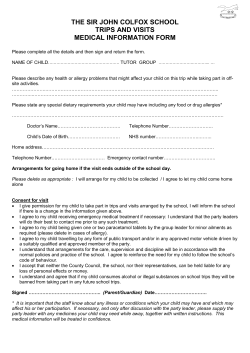
Slips and Trips in Aged Care Hazard
HAZARDS Slips and Trips in Aged Care Slips and trips are one of the most common causes of workplace injuries in the aged care environment. They most commonly result in musculoskeletal injuries, cuts, bruises, fractures and dislocations but have the potential to cause much more serious injuries. Slips usually occur when there is a loss of grip between a person’s shoe and the floor. Trips occur when a person’s foot hits a low object in their path, causing a loss of balance. Factors that can contribute to the risk of slips and trips in an aged care environment may include: Wearing footwear that is not appropriate for the work environment Storage of objects in walkways and high traffic areas eg. trollies left in corridors Spills Uneven, slippery or loose floor coverings Inadequate cleaning Poor lighting Fatigue, and Rushing. Some fairly simple strategies that should reduce the likelihood of injury include: Ensuring all workers wear appropriate, rubber soled shoes Good housekeeping eg. cleaning floors thoroughly and regularly Ensuring lighting is adequate Keeping corridors and walkways clear Placing non-slip matting at building entrances, and Keeping electrical cords out of foot traffic areas or securely covered. When might this hazard occur? Wearing inappropriate footwear can be a major slipping hazard, especially in wet areas such as bathrooms and kitchens. Implementing a policy requiring workers to wear suitable non-slip footwear will reduce the likelihood of injury from slips and trips. Slips are common in wet areas like kitchens and bathrooms where frequent washing, spills, worn flooring and cleaning products can all contribute to the risk. Aged care facilities should ensure floors are cleaned regularly, any spills are immediately cleaned and safety signage is erected to reduce the likelihood of an accident or injury. Office areas pose many potential trip hazards. Computer and photocopier cables, boxes of resident files and other loose objects are common causes of trips and injuries. Ensuring cables and cords are secured away from high traffic areas and implementing procedures and policies will reduce the risk. What do I need to do? Under work health and safety legislation, aged care facilities have a duty to provide a safe and healthy workplace. In order to meet these obligations and their duty of care to residents, an aged care facility must have robust policies in place in relation to slips and trips. The facility must also provide adequate training and respond to and investigate complaints. Some key considerations are: Consult with workers, work health and safety representatives and supervisors to identify the risk in relation to slips and trips. Practical Help SafeWork Australia WorkCover NSW Victorian WorkCover Authority SafeWork SA WorkSafe NT WorkSafe WA WorkSafe Tasmania Workplace Health and Safety Queensland (WHSQ) WorkSafe ACT Ask yourself these questions: • What might happen? • When might it happen? • Why might it happen? • What could cause this to happen? (there may be multiple causes) Ensure policies and procedures are in place. Identify workers who may be at higher risk. Provide all workers with appropriate information, instruction and training to identify the risk factors associated with slips and trips and the role they have to play in reducing the risk. Consider what you are currently doing to manage the risk and whether it is effective (these are also known as controls). Develop and implement any new controls necessary. If you would like further information about Slips and Trips in Aged Care, please contact the risksupport Helpdesk on: www.risksupport.org.au Catholic Church Insurance Limited ABN 76 000 005 210, AFSL no. 235415 GPO Box 180 Melbourne 3001 1300 660 827 helpdesk@risksupport.org.au www.risksupport.org.au Important Notice: This publication is intended to provide a summary and general information only to clients of Catholic Church Insurance Limited. It does not constitute, and should not be relied on as advice or considered as a comprehensive coverage of the topics discussed. You should seek professional advice tailored to your own circumstances. CCI RM290 0614
© Copyright 2025









